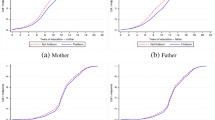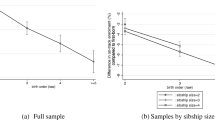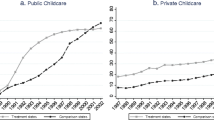Abstract
AIDS deaths could have a major impact on economic development by affecting the human capital accumulation of the next generation. We estimate the impact of parent death on primary school participation using an unusual five-year panel data set of over 20,000 Kenyan children. There is a substantial decrease in school participation following a parent death and a smaller drop before the death (presumably due to pre-death morbidity). Estimated impacts are smaller in specifications without individual fixed effects, suggesting that estimates based on cross-sectional data are biased toward zero. Effects are largest for children whose mothers died and, in a novel finding, for those with low baseline academic performance.
Similar content being viewed by others
References
Adetunji, J. 2000. “Trends in Under-5 Mortality Rates and the HIV/AIDS Epidemic.” Bulletin of the World Health Organization 78:1200–206.
Aigner, D.J. 1973. “Regression With a Binary Independent Variable Subject to Errors of Observation.” Journal of Econometrics 1(1):49–50.
Ainsworth, M., K. Beegle, and G. Koda. 2005. “The Impact of Adult Mortality and Parental Deaths on Primary Schooling in North-Western Tanzania.” Journal of Development Studies 41:412–39.
Ainsworth, M. and D. Filmer. 2002. “Poverty, AIDS, and Children’s Schooling: A Targeting Dilemma.” Policy Research Working Paper No. 2885. World Bank, Washington, DC.
Ainsworth, M. and I. Semali. 1998. “Who is Most Likely to Die of AIDS? Socioeconomic Correlates of Adult Deaths in Kagera Region, Tanzania.” Pp. 95–109 in Confronting AIDS: Evidence From the Developing World, edited by M. Ainsworth, L. Fransen, and M. Over. Brussels: European Union.
Case, A. and C. Ardington. 2006. “The Impact of Parental Death on School Outcomes: Longitudinal Data From South Africa.” Demography 43:401–20.
Case, A., C. Paxson, and J. Ableidinger. 2004. “Orphans in Africa: Parental Death, Poverty, and School Enrollment.” Demography 41:483–508.
Central Bureau of Statistics and Ministry of Health [Kenya]. 2004. Kenya Demographic and Health Survey 2003. Nairobi, Kenya: Central Bureau of Statistics. Available online at http://www.cbs. go.ke/downloads/pdf/Kenya_Demographic_and_Health_Survey_2003_Preliminary_Report.pdf
Evans, D. 2004. “The Spillover Impacts of Africa’s Orphan Crisis.” Unpublished manuscript. RAND Corporation, Santa Monica, CA
Evans, D. and E. Miguel. 2004. “Orphans and Schooling in Africa: A Longitudinal Analysis.” BREAD Working Paper No. 56. Bureau for Research and Economic Analysis of Development, Cambridge, MA.
Filmer, D. and L. Pritchett. 2001. “Estimating Wealth Effects Without Expenditure Data—or Tears: An Application to Educational Enrollment in States of India.” Demography 38:115–32.
Foster, G., R. Shakespeare, F. Chinemana, H. Jackson, S. Gregson, C. Marange, and S. Mashumba. 1995. “Orphans Prevalence and Extended Family Care in a Peri-urban Community in Zimbabwe.” AIDS Care 7(1):3–18.
Foster, G. and J. Williamson. 2000. “A Review of Current Literature on the Impact of HIV/AIDS on Children in Sub-Saharan Africa.” AIDS 14(Suppl. 3):S275-S284.
Gertler, P., D. Levine, and M. Ames. 2004. “Schooling and Parental Death.” Review of Economics and Statistics 86(1):211–25.
Kamali, A., J.A. Seeley, A.J. Nunn, J.F. Kengeya-Kayondo, A. Ruberantwari, and D.W. Mulder. 1996. “The Orphans Problem: Experience of a Sub-Saharan Africa Rural Population in the AIDS Epidemic.” AIDS Care 8:509–15.
Lloyd, C. and A. Blanc. 1996. “Children’s Schooling in Sub-Saharan Africa: The Role of Fathers, Mothers, and Others.” Population and Development Review 22:265–98.
Lundberg, M., and M. Over. 2000. “Transfers and Household Welfare in Kagera.” Unpublished manuscript. World Bank, Washington, DC.
Manski, C. 1995. Identification Problems in the Social Sciences. Cambridge, MA: Harvard University Press.
Marum, L., J. Muttunga, F. Munene, and B. Cheluget. 2004. “HIV Prevalence and Associated Factors.” Pp. 217–32 in Kenya: Demographic and Health Survey 2003. Nairobi, Kenya: Central Bureau of Statistics.
Miguel, E. and M.K. Gugerty. 2005. “Ethnic Diversity, Social Sanctions, and Public Goods in Kenya.” Journal of Public Economics 89:2325–68.
Miguel, E. and M. Kremer. 2004. “Worms: Identifying Impacts on Education and Health in the Presence of Treatment Externalities.” Econometrica 72(1):159–217.
Morgan, D., S.S. Malamba, J. Orem, B. Mayanja, M. Okongo, and J.A.G. Whitworth. 2000. “Survival by AIDS Defining Condition in Rural Uganda.” Sexually Transmitted Infections 76:193–97.
Morgan, D. and J.A.G. Whitworth. 2001. “The Natural History of HIV-1 Infection in Africa.” Nature Medicine 7(2):143–45.
Ntozi, J.P.M. 1997. “Effect of AIDS on Children: The Problem of Orphans in Uganda.” Health Transition Review 7(Suppl.):23–40.
ORC Macro. DHS Statcompiler. 2005. Available online at http://www.measuredhs.com/statcompiler/ start.cfm
Robinson, S. 1999. “Orphans of AIDS.” TIME 154(24):60–61.
Ryder, R., M. Kamenga, M. Nkusu, V. Batter, and W. Heyward. 1994. “AIDS Orphans in Kinshasa, Zaire: Incidence and Socioeconomic Consequences.” AIDS 8:673–79.
UNAIDS. 2000. Socioeconomic Impact of HIV/AIDS in Africa. Available online at http://www. unaids.org
UNAIDS. 2002. Report on the Global HIV/AIDS Epidemic. Available online at http://www.unaids. org
UNAIDS, UNICEF, and USAID. 2002. Children on the Brink 2002: A Joint Report on Orphan Estimates and Program Strategies. Available online at http://www.unicef.org/publications/index_ 4378.html
UNAIDS, UNICEF, and USAID. 2004. Children on the Brink 2004: A Joint Report of New Orphan Estimates and a Framework for Action. Available online at http://www.unicef.org/publications/index_22212.html
United Nations Development Programme (UNDP). 2002. Human Development Indicators 2002. Available online at http://hdr.undp.org
Watson, C. 1992. “RAPing in Chad.” Pp. 409–16 in Rapid Assessment Procedures: Qualitative Methodologies for Planning and Evaluation of Health Related Programmes, edited by N.S. Scrimshaw and G.R. Gleason. Boston: International Nutrition Foundation for Developing Countries.
Wehrwein, P. 2000. “AIDS Leaves Africa’s Economic Future in Doubt.” Available online at http:// www.cnn.com/SPECIALS/2000/aids/stories/economic.impact/
World Bank. 2002. Education and HIV/AIDS: A Window of Hope. Washington, DC: The World Bank.
Yamano, T. and T.S. Jayne. 2004. “Measuring the Impact of Working-Age Adult Mortality on Small-Scale Farm Households in Kenya.” World Development 32(1):91–119.
—. 2005. “Working-Age Adult Mortality and Primary School Attendance in Rural Kenya.” Economic Development and Cultural Change 53:619–54.
Young, A. 2005. “The Gift of Dying: The Tragedy of AIDS and the Welfare of Future African Generations.” Quarterly Journal of Economics 120:423–66.
Author information
Authors and Affiliations
Corresponding author
Additional information
We are grateful for financial support from the World Bank, the Partnership for Child Development, the Harvard Center for International Development, the Harvard University Inequality Program, and the National Institutes of Health Fogarty International Center (R01 TW05612-02). We thank ICS Africa and the Kenya Ministry of Health Division of Vector Borne Diseases for their cooperation in all stages of the project, and we would especially like to acknowledge the contributions of Elizabeth Beasley, Laban Benaya, Pascaline Dupas, Simon Brooker, Alfred Luoba, Sylvie Moulin, Robert Namunyu, Polycarp Waswa, and the PSDP eld staff and data group, without whom the project would not have been possible. Harold Alderman, Josh Angrist, Gustavo Bobonis, Anne Case, Caroline Hoxby, Larry Katz, Michael Kremer, participants in seminars at Harvard, the World Bank, 2004 NBER Summer Institute, USC, Oxford, 2005 IUSSP seminar on “Interactions Between Poverty and HIV/AIDS,” and University of California, Berkeley, have provided valuable comments, as have the editors of this journal and two anonymous referees. Melissa Gonzalez-Brenes and Tina Green have provided excellent research assistance. This is a substantially revised version of BREAD Working Paper No. 56 (see Evans and Miguel 2004). All errors are our own.
Rights and permissions
About this article
Cite this article
Evans, D.K., Miguel, E. Orphans and schooling in africa: a longitudinal analysis. Demography 44, 35–57 (2007). https://doi.org/10.1353/dem.2007.0002
Issue Date:
DOI: https://doi.org/10.1353/dem.2007.0002




